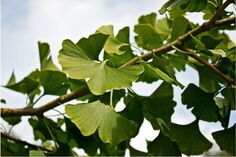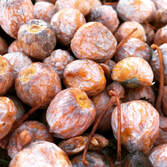 When we moved our farm in 2014, Paul’s mom brought us two ginkgo seedlings as a housewarming gift. I've been fascinated with these weirdos ever since. With its distinctive fan-shaped leaf, there’s nothing quite like a ginkgo. The ginkgo is often described as a “living fossil” because of its ancient beginnings and lack of living relatives. Ginkgo are dioecious, meaning that individual specimens are either male or female. Due to their unique silhouette and stunning autumn display of yellow, ginkgoes are popular street trees. Well, the male ginkgoes at least. Female trees are less significantly popular, because they produce a fruit that is – shall we say – stanky. Think decaying flesh meets rotten eggs.  I know I’m in the minority as one who wholeheartedly appreciates the female ginkgoes. It is, in fact, only due to the female trees that I have any ginkgoes at all: the seedlings we were gifted as housewarming favors began as dropped seeds from a female tree in my inlaws' front yard.  So now every year we make a pilgrimage back to Paul’s parents’ house, where we gather the ginkgo seeds in all their stanky glory (and have at least once returned later in the season for wayward seedlings). Propagating ginkgoes from seed isn't super common in the nursery trade because this would result in a 50/50 male and female trees in the next generation, and the female trees are much less desirable. But seeds are what I've got, so seeds are what I'll work with. I start by soaking the fruits overnight in water. Lots of seeds benefit from a good overnight soak before sowing, but for ginkgoes, it also helps loosen the flesh to reveal the true seed. Then, wearing gloves (because the flesh can cause allergic reactions) and a face mask (because they are, once again, stanky), I begin the process of squishing each hard seed out of its meaty fruit. Once the seeds have been defleshed it's simply a matter of planting them out. I start mine in soil beds in mid-late January so they can achieve a full stratification period before the last frost. Repeating this each year has yielded us hundreds and hundreds of ginkgoes.  So what are we going to do with hundreds and hundreds of ginkgoes? …Honestly, this is a great question. As mentioned previously, almost no one wants a female ginkgo as a yard tree. Since these were propagated from seed instead of asexually, there is no way to know which seedlings are male vs. female. My first plan was to train the females for pre-bonsai and market the males as street & yard trees. Then I found out it will take about 20 years for them to develop the sex-indicating flowers, and well, ain’t nobody got time for that.  So, it looks like instead I’ll be developing ALL the ginkgoes as pre-bonsai. They’ll take a few years to be salable as well, but I’m looking forward to starting my mini ginkgo forest this spring. Surely I'll post an update then, because it's bound to be adorable.
0 Comments
Leave a Reply. |
AuthorErin runs the blog for Thirsty Boot Farms. Archives
March 2022
Categories |
 RSS Feed
RSS Feed
